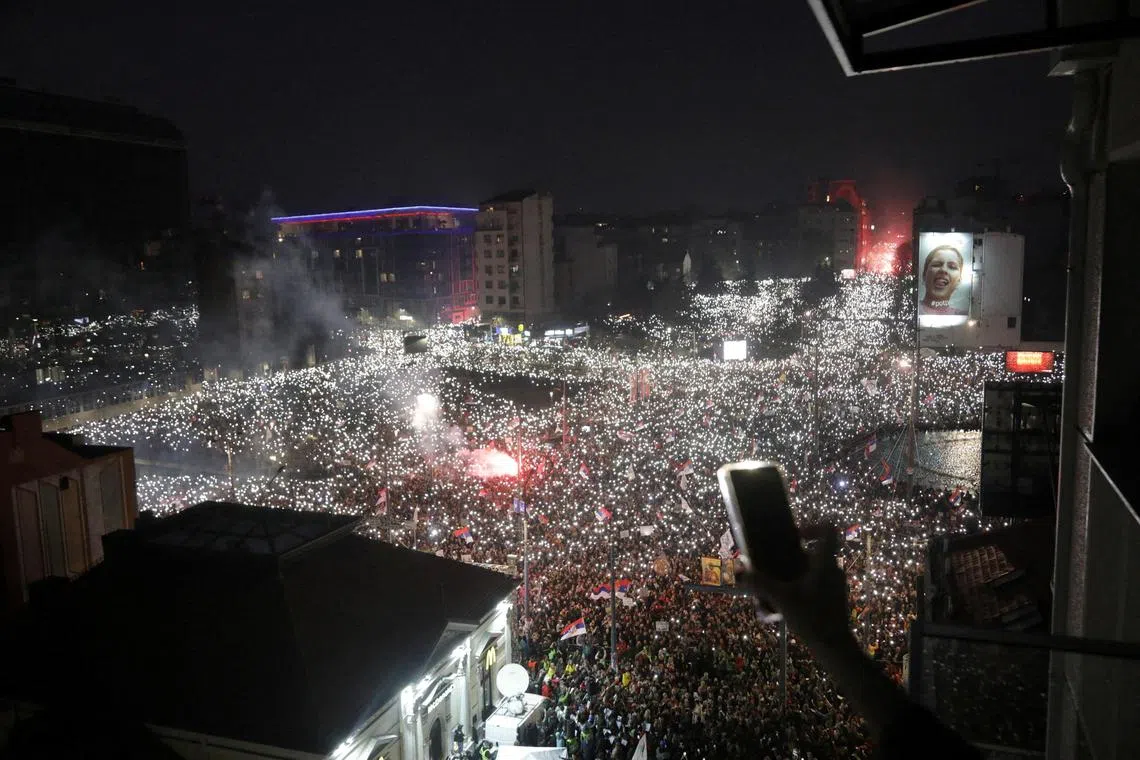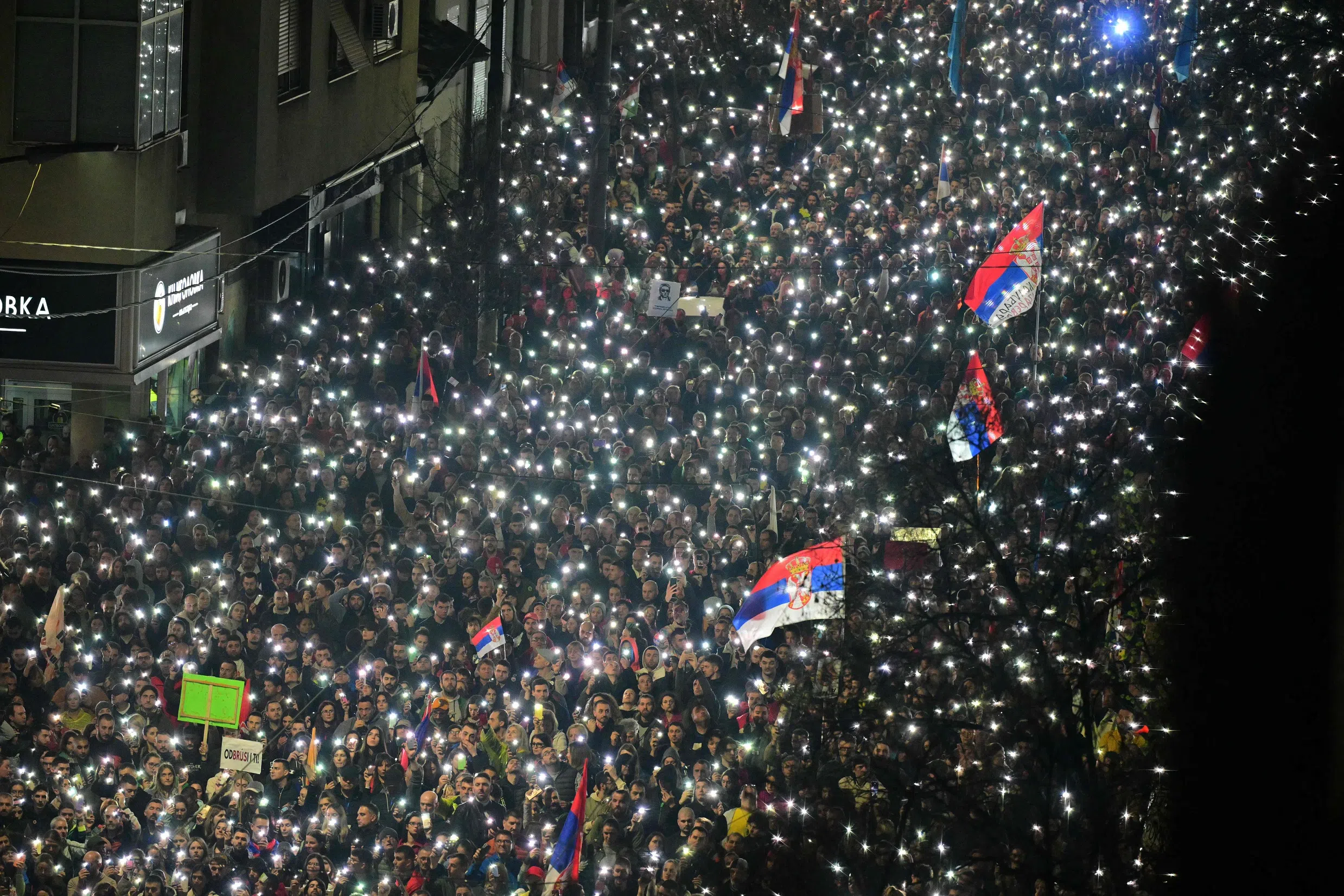Over 100,000 turn out in Serbia’s capital for anti-graft rally
Sign up now: Get ST's newsletters delivered to your inbox

Protesters in Belgrade on March 15 commemorating the people who died when a railway station roof collapsed in Novi Sad in November 2024.
PHOTO: REUTERS
Follow topic:
BELGRADE – More than 100,000 protesters converged in Serbia’s capital Belgrade on March 15 in what could be the largest in a series of anti-corruption demonstrations that have upended the Balkan country in recent months.
The movement formed after 15 people were killed when a railway station roof collapsed
But with supporters of President Aleksandar Vucic’s embattled government also gathering in the capital, there was growing concern about the risk of clashes.
In statements issued on social media, students urged those attending the rally to act “in a calm and responsible manner”.
“The purpose of this movement is not an incursion into institutions, nor to attack those who do not think as we do,” read one statement.
“This movement must not be misused.”
Lawlessness and corruption
For weeks, student-led protesters have criss-crossed the country, holding rallies in Serbia’s major cities.
They have also taken their anti-corruption crusade to the rural areas and small towns that have long been the backbone of Mr Vucic’s support.
The return to Belgrade on March 15 will most likely further ramp up already compounding pressure on the government, with several high-ranking officials, including the prime minister, having resigned in recent months.
Like others before it, the March 15 protest cut across a wide spectrum of society, bringing together those aligned with the far left and right.
Amid scores of Serbian flags, some waved banners calling for environmental protection, while others demanded the return of the former breakaway province of Kosovo.
“We have gathered in the streets primarily to express our complete dissatisfaction after years of dictatorship, lawlessness and corruption,” said Mr Ognjen Djordjevic, a 28-year-old resident from Belgrade.
“I hope this gathering remains, above all, peaceful and dignified.”
At one point, the crowd stretched for nearly 2km, with people filling the streets in and around the Parliament, the capital’s main pedestrian square and another key traffic intersection.

Thousands of protesters holding up their mobile phones in memory of those who died in November, when a train station roof collapsed in Serbia’s Novi Sad.
PHOTO: AFP
The Interior Ministry later said that at least 107,000 people had turned out for the demonstration, noting that no major incidents had occurred so far.
Ahead of the main afternoon protest, thousands also stood for 15 minutes of silence beginning at 11.52am to honour the victims of the Novi Sad tragedy, with the time marking the moment of the roof’s collapse.
Farmers, students, bikers and other civilians mingled along the main thoroughfares in downtown Belgrade, as a parade of tractors headed towards the Parliament.
“We came for justice. I hope that after this protest, things will change,” Ms Milica Stojanovic, a student at the Faculty of Biology in Belgrade, told AFP.
‘I will not be pressured’
But government supporters also mobilised in the capital, including ultranationalists, militia members and alleged football hooligans who set up barricades near the Parliament.
That led to fears of a possible confrontation with the student-led demonstrators.
But after marching through the area near Parliament on the afternoon of March 15, protest organisers largely cleared the main street in front of the legislator to help prevent a confrontation.
Layers of riot police also fanned out near the encampment and around the Parliament.
On the evening of March 14, Mr Vucic took to the airwaves with a defiant message as demonstrators began to trickle into the city, vowing to not back down in the face of mass protests.
“Just to be clear, I will not be pressured,” said Mr Vucic during a national televised address.
“I’m the President of Serbia and I won’t let the streets set the rules in this country.”
He went on to call on all sides to refrain from using violence and instructed police to not use excessive force.

The Interior Ministry said at least 107,000 people had turned out for the demonstration.
PHOTO: AFP
On the night of March 14, thousands lined Belgrade’s streets to welcome student protesters arriving in the capital after they marched for days from cities across Serbia.
“There definitely won’t be any violence here because we all came with the same purpose – to wait for the people who marched, the people who are liberating Serbia,” said Ms Tijana Djuric – a 20-year-old student at the Faculty of Economics in Belgrade.
‘Regime escalating tensions’
Some analysts had earlier warned that the situation could escalate.
“We can already see for a few days that the regime is trying to escalate tensions,” said political analyst Srdjan Cvijic.
“It is creating a Potemkin village of support in front of the presidency with pro-government demonstrators who are paid.”
Government-backed media outlets have broadcast increasingly inflammatory accusations, saying the students are planning to launch a “coup”, and Mr Vucic accused the demonstrators of organising “large-scale violence”.
Mr Vucic has warned of a “final” showdown on March 15, while some student protesters said they would continue to rally until their demands for greater accountability were met. AFP

